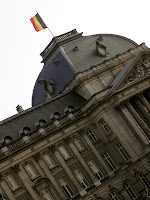 as setting and I was in probably the most picturesque medieval city I could imagine. The green patches of grass and vegetation complementing everything else brick and stone is eye candy for any traveler. I was particularly impressed at how the city seemed to remain largely untouched by modernization (in an architectural sense). I thought of it as a quieter, more scaled-down Amsterdam with a clear, and attractive, historical energy.
as setting and I was in probably the most picturesque medieval city I could imagine. The green patches of grass and vegetation complementing everything else brick and stone is eye candy for any traveler. I was particularly impressed at how the city seemed to remain largely untouched by modernization (in an architectural sense). I thought of it as a quieter, more scaled-down Amsterdam with a clear, and attractive, historical energy.In most other cities I’ve visited thus far, infrastructural modernization and a progressive culture have clearly influenced the landscape, as well as affected the population's identity as a member of the landscape. Bruges, however, seems to have eluded many present changes that eradicate past culture. This is no more evident than in the old city and city center portion of the city. This ancient map shows how little the layout of the city center has changed over time. Not to say that there isn’t significant commercialization and touristic plans, but Bruges’s “magic” comes its ability to maintain a distinct Flemish identity in multiple ways.
The wealth that Bruges has accumulated over the past centuries is evident in the beauty, cleanliness, and sophistication of the old city. As the city’s own website explains, Bruges has a “long tradition of international port activity,” which leads to an influx of wealth and culture alike. The city most likely began as a Roman military fortification against invading Germanic tribes; gradually it became involved in trading with Scandinavian countries. Although it is not located on the coast itself, the canals that run throughout the medieval streets once allowed Bruges to be the trading capital of northwest Europe. The modern concept of Bruges, and rightfully so, is not a seaside urban landscape; Bruges's identity was eventually morphed with societal advances. Because of its cultural and architectural accomplishments, Bruges has mostly shed the image of being strictly a port city. The old city is a relic of the Flemish identity Bruges maintains.
There are strips of cobblestone that bear the mark of commercialism, but for the most part, Bruges has resisted instincts to completely rely on tourism for economic prosperity. The tourism aspect of Bruges is most evident during the day, but unlike other travel destinations, is relatively quiet at night. Bruges’s atmosphere is certainly not party-focused; the demographic of tourists it attracts seems to be an older crowd. Tourism will most likely increase in Bruges in the future, but for the time being, the city expertly balances its past identity with urges to modernize.
Bruges is as modernized as any other city, but sustains a uniquely historical ambiance. Importantly, the United Nations Educational, Scientific and Cultural Organization (UNESCO) recognized the historic city center of Bruges as a World Heritage Site. Bruges’s old brick infrastructure exemplifies “a considerable exchange of influences on the development of architecture,” among other criteria needed for a World Heritage Site. Although this may not be a well-known award to many, it nonetheless speaks to the importance citizens of Bruges place on maintaining the city’s historical integrity. Integration int
 o a more European identity has taken place in Bruges, but not to the extent as other regions of Belgium, namely Brussels, where integration operations are centered. As part of the Flemish region of Belgium, Bruges most clearly symbolizes Flemish culture through its ability to maintain its history even when social, cultural, and economic forces work against it.
o a more European identity has taken place in Bruges, but not to the extent as other regions of Belgium, namely Brussels, where integration operations are centered. As part of the Flemish region of Belgium, Bruges most clearly symbolizes Flemish culture through its ability to maintain its history even when social, cultural, and economic forces work against it.Bruges is the crossroads of everything that is Flemish. It has the old churches and monuments, traditional Flemish food, medieval architecture and a quiet and slow energy. I can’t say enough about how impressed I was with Bruges’s resistance to the fast-paced, heavy partying, gaudy atmosphere that has infested many other historical cities I have visited. Any traveler looking to experience a historical culture in the confines of a comfortable and relaxing city look no further than Bruges and its old city center.


















